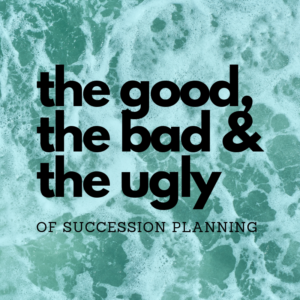Mary E. Marshall's Blog, page 16
May 8, 2019
Leadership: The Good, the Bad and the Ugly of Succession
 In the 25+ years or so that I’ve been working with small to mid-sized businesses, I’ve seen just about every type of “end.” Some good, some not so good.
In the 25+ years or so that I’ve been working with small to mid-sized businesses, I’ve seen just about every type of “end.” Some good, some not so good.
Let’s start with “the ugly.” One entrepreneur grew his business to about $15M and wanted to leave it to his employees. He worked with his executive team for three years on an ESOP strategy and finally pulled the plug. He retained the majority of shares in the first year with the full earn-out over a five year period. However, after year one a very strategic buyer showed up and made an offer that was a win for everyone. Due to the way the ESOP was structured, the employees were able to turn the deal down, even though they did not have the majority of shares. Needless to say, this caused some serious animosity between the parties and the undoing of the ESOP. Trust was broken and no one ended up happy with a broken company and no buyers in sight. The lesson here? Make sure everyone’s expectations are matched and the documents reflect those expectations.
Next comes “the bad.” This was a software company that had multiple suitors, all very strategic buyers. However, the founder/owner couldn’t figure out what his role should be after the sale. Because he wasn’t sure, he kept dragging his feet and eventually, both buyers lost patience and went away. The founder couldn’t understand he alone was the reason the deal didn’t come together. He assumed that there would be many more buyers after those, and there were not. The original buyers picked off his engineers and developed a competing technology. The opportunity completely missed, never to make an appearance again. Lesson? Know what you will do after you sell – you’ll look at potential deals differently.
Lastly, let’s talk about “the good.” This is the way we all want it to go. The founder had a clear plan. Grow the business to $25M, position it to be acquired by one of three strategic partners, stay on for a year, then call it a day and retire to race his sailboats, and travel with his wife. At the ten year mark, he had the revenue track he wanted and had made inroads with all three potential buyers. He decided to pull the trigger and engaged a good investment banker to prepare the business and then work with the buyers. He ended up getting twice the multiple he had anticipated and the contract post-sale he wanted. He was clear what he was negotiable on and what he wasn’t. He was able to negotiate good contracts for his key players and ensure that the rest of his employees were well taken care of. His “baby” was in good hands and today is still going strong. The lesson? Starting with the end in mind works.
The post Leadership: The Good, the Bad and the Ugly of Succession appeared first on Mary Marshall // CEO Coach.
April 30, 2019
Good Leaders Don’t Go It Alone
 A recent article in Forbes asked several experts what they did when faced with difficult business problems. Hands down, they all agreed that asking for help was a good thing. The three agreed with the following:
A recent article in Forbes asked several experts what they did when faced with difficult business problems. Hands down, they all agreed that asking for help was a good thing. The three agreed with the following:
Cultivate Relationships
Don’t Face It Alone
Reframe the Problem
Having worked with multiple entrepreneurs over the years, what happens to most in their early years is they think they need to do it all. For a variety of reasons, they believe it’s how it’s done, and they are driven. They believe their business is unique and most just tough it out. It’s only after talking with others in their same situation do, they realize the best solutions come from sharing and working with others – not from sheer fortitude.
Cultivating those relationships that you may need down the road should start early in your entrepreneurial journey. You will not have all the answers and there are experts in every corner that will be able to help when you need it. It is not a sign of weakness to ask for help, in fact, it’s a sign of strength to know when you need help.
Regardless of whether one of these relationships can help, you will need others at least as sounding boards. Good leaders know that sometimes just talking about the issue is the first step to solving it. Sometimes thinking over the issue in one’s own head just leads to more puzzles or circular thinking. Talking it out with someone else, particularly someone who has been through something similar will often open new avenues of thinking.
Lastly, reframing the issue will always help you see it from a completely different perspective. It’s optimal to collaborate with someone else for this. In most cases, the best inventions and innovations were created with different thinking than what generated the original.
It is not a sign of brilliance or strength to solve problems on your own – good leaders know this. Those leaders who do not know this are stuck in a cocoon of their own making. They start to create a narrative that supports their beliefs and then surround themselves with those who agree – or are afraid to question it. This unintentionally supports the “brilliant” hypothesis and shuts out anything else. Ultimately, this will lead to less than optimal ideas and solutions. No one is more brilliant alone, no one is perfect and great solutions come through collaboration with others. Good leaders know this.
The post Good Leaders Don’t Go It Alone appeared first on Mary Marshall // CEO Coach.
April 24, 2019
Succession: The Good, the Bad and the Ugly
 In the 25+ years or so that I’ve been working with small to mid-sized businesses, I’ve seen just about every type of “end.” Some good, some not so good.
In the 25+ years or so that I’ve been working with small to mid-sized businesses, I’ve seen just about every type of “end.” Some good, some not so good.
Let’s start with “the ugly.” One entrepreneur grew his business to about $15M and wanted to leave it to his employees. He worked with his executive team for three years on an ESOP strategy and finally pulled the plug. He retained the majority of shares in the first year with the full earn-out over a five year period. However, after year one a very strategic buyer showed up and made an offer that was a win for everyone. Due to the way the ESOP was structured, the employees were able to turn the deal down, even though they did not have the majority of shares. Needless to say, this caused some serious animosity between the parties and the undoing of the ESOP. Trust was broken and no one ended up happy with a broken company and no buyers in sight. The lesson here? Make sure everyone’s expectations are matched and the documents reflect those expectations.
Next comes “the bad.” This was a software company that had multiple suitors, all very strategic buyers. However, the founder/owner couldn’t figure out what his role should be after the sale. Because he wasn’t sure, he kept dragging his feet and eventually, both buyers lost patience and went away. The founder couldn’t understand he alone was the reason the deal didn’t come together. He assumed that there would be many more buyers after those, and there were not. The original buyers picked off his engineers and developed a competing technology. The opportunity completely missed, never to make an appearance again. Lesson? Know what you will do after you sell – you’ll look at potential deals differently.
Lastly, let’s talk about “the good.” This is the way we all want it to go. The founder had a clear plan. Grow the business to $25M, position it to be acquired by one of three strategic partners, stay on for a year, then call it a day and retire to race his sailboats, and travel with his wife. At the ten year mark, he had the revenue track he wanted and had made inroads with all three potential buyers. He decided to pull the trigger and engaged a good investment banker to prepare the business and then work with the buyers. He ended up getting twice the multiple he had anticipated and the contract post-sale he wanted. He was clear what he was negotiable on and what he wasn’t. He was able to negotiate good contracts for his key players and ensure that the rest of his employees were well taken care of. His “baby” was in good hands and today is still going strong. The lesson? Starting with the end in mind works.
The post Succession: The Good, the Bad and the Ugly appeared first on Mary Marshall // CEO Coach.
April 17, 2019
Good Leaders Know Why EQ Matters
 Which is more important for a leader, EQ or IQ? According to Daniel Goleman’s “What Makes a Leader – Why EQ Matters,” they are both equally important but in very different ways. A leader needs to be smart and have reasoned approaches to the direction their organization is headed. In other words, they have a very good “why” behind their business strategy. Research, data, and evidence behind every strategic decision should give the employees some confidence that the leader knows what she or he is doing. This is the IQ part.
Which is more important for a leader, EQ or IQ? According to Daniel Goleman’s “What Makes a Leader – Why EQ Matters,” they are both equally important but in very different ways. A leader needs to be smart and have reasoned approaches to the direction their organization is headed. In other words, they have a very good “why” behind their business strategy. Research, data, and evidence behind every strategic decision should give the employees some confidence that the leader knows what she or he is doing. This is the IQ part.
The emotional intelligence part, or EQ, is the way in which the leader engages the rest of the team to implement the strategy. Without this, the best strategies built with the highest IQ’s are dead in the water. This is the “why” we should do something the way the strategy is calling for. Good leaders know that “WIIFM” (What’s In It For Me) is paramount to explaining why everyone should line up behind a particular strategy. The leader who leads with “how smart they are” first, will step all over the “why” of the strategy and will turn around to find no one following.
Ever been in the presence of someone brilliant and you were energized by the ideas they were talking about and couldn’t wait to get started? Then the person to the left or right says “yeah, but they’re a real jerk?” It has a way of putting a pretty big damper on that enthusiasm. High IQ, low EQ. In order to enable the ideas to gain traction, EQ is required. Good EQ starts with knowing yourself first, what you do well and do not do well. Sharing the responsibility or delegating those things that are not in your wheelhouse and engaging others to help get the strategy over the line are critical. It’s why those very socially awkward leaders – either belligerent, egotistical or shy – never get talked about without the asterisk behind their names. There’s a “but” to their brilliance. Some are willing to put up with the “but” to be in the presence of greatness, but most would like both EQ and IQ combined for an implementable brilliance.
Leaders who don’t explain things because the staff is “too stupid” to understand, fall in this category. As if giving them a little catnip at the completion of a task will be good enough to get it over the finish line. It won’t. People want to be engaged, appreciated and listened to before they buy into a leader’s plan. Even if you think of yourself as the smartest person in the room, it won’t matter if you need others to make whatever you came up with happen.
Create strategies with IQ, implement them with EQ. Without the first, you will have implemented a bad plan, without the latter, no plan at all will be implemented.
The post Good Leaders Know Why EQ Matters appeared first on Mary Marshall // CEO Coach.
April 10, 2019
Where Does Good Leadership Start?
 Leadership is the hot topic these days – who should be the leader? How should they lead? What is leadership behavior? All good questions and depending on your perspective, there are multiple good answers. When someone asks me about “leadership” or what type of “leader” they should be or what does a successful leader look like, I usually start by asking “who” they are, meaning, who are they personally? Professionally? What do they believe and stand for? All of these make up their character and if you don’t lead with congruency to your own character, it’s game over.
Leadership is the hot topic these days – who should be the leader? How should they lead? What is leadership behavior? All good questions and depending on your perspective, there are multiple good answers. When someone asks me about “leadership” or what type of “leader” they should be or what does a successful leader look like, I usually start by asking “who” they are, meaning, who are they personally? Professionally? What do they believe and stand for? All of these make up their character and if you don’t lead with congruency to your own character, it’s game over.
So many leaders try to fit into a mold they believe is what a good leader looks like – which may or may not fit with who they are. If you try to lead in a way that is not consistent with your values, you won’t be leading for very long. Like a dog who can sense fear in a human, those who follow can instantly sense inauthenticity in a leader. A disconnect between what they say and what they do. There is not a costume you can don to put on your “leadership” and instantly transform like Clark Kent into a super leader. The only “costume” is the one you wear all the time.
Character is defined by Webster’s as “the mental and moral qualities distinctive to an individual.” People look to leaders to have qualities like integrity and authenticity and these are all part of what makes up character. Leaders who lead with their own character and values are so far ahead of the rest of the pack that it looks like they got a mile head start. Don’t worry about what people think of you or how you are going to look. If your character and values are your guides, you will always do right by you and usually by others as well.
People make the choice to follow a leader – or not – if they believe the leader has the ability to help the organization and its people get somewhere they could not or would not get on their own. The leaders that have what they believe to be character will be the ones they follow even though they may not truly believe or understand the mission or the “how” of the situation just yet. The decision relies on the willingness to “trust.” At the heart of every leader we follow is that for now we “trust” them more than we trust ourselves to go it alone. When trust breaks down, the followers go away. Even worse, they can rebel, and chaos can ensue.
Leaders start by trusting themselves, being true to their character and values and doing the right thing (to the best of their ability or knowledge). Whether leading an organization, a group, your family or yourself, the easiest path is to start by leading with your own true self – your character.
The post Where Does Good Leadership Start? appeared first on Mary Marshall // CEO Coach.
April 3, 2019
7 Traits that Can Hold You Back as a Leader
 I am frequently asked what makes a great leader and aside from being authentic and aligned with the company’s values, it’s hard to pin the actual traits down. An excellent read recently published in Fast Company about the traits that got you there but won’t necessarily serve you in a leadership role offers a good answer to the question.
I am frequently asked what makes a great leader and aside from being authentic and aligned with the company’s values, it’s hard to pin the actual traits down. An excellent read recently published in Fast Company about the traits that got you there but won’t necessarily serve you in a leadership role offers a good answer to the question.
Moving up from being a successful individual contributor to a successful leader can be a tough transition – going from “doing” to “being” a leader is never as smooth as one would hope. Previously, I wrote that one of the most important things to do in your career is to guard your reputation – and along with that, here are the seven traits that the author identifies can hold you back from a successful transition to leadership:
Being Precise and Correct
Focusing on Strong Technical Skills
Seeking Ownership and Recognition
Self-Reliance
Networking
A Large Appetite for Risk
Patience
While building your skills in a workplace, you need all of the above to do well and more importantly, to be noticed. However, as you transition to leader, it means most of these will be far less useful than they once were. For example, being precise and correct will not help you develop leaders below you and focusing on the technical skills ignores the obvious people skills you will need to develop as a leader. Leadership is getting things done through others, not doing them yourself.
While building a reputation and finding your leadership footing it’s natural to want people to notice you so you will take credit for things as appropriate. However, as a leader, if you take credit for things your team did, you will build resentment. It’s better to give credit than to take it as a leader. While Self-Reliance is regarded as a “can-do” spirit as a team member, if you start doing everything yourself and leaving your team out, you will look behind you and no one will be following. You can’t lead if the team has abandoned you.
Networking is an interesting one because you will need to keep networking, just not as much. Your networking should become more focused and purposeful and your “ask” should be known in advance. You should think about it more strategically, not transactionally.
The last two traits, a large appetite for risk and patience might seem counterintuitive. Don’t we want these traits as leaders? However, the more responsibility you have, the more your appetite for risk will and should go down because the consequences of a bad decision are larger and potentially more long-lasting. As an individual contributor, you were patient for your opening but as a leader, you will have bigger demands on you and therefore you need to have less patience for poor performance, and you need opportunities to prove your team’s worth, not just your own.
As with anything, success is always in the timing. Know what you need to bring to the table at the right time and what you need to put away for future use. Leadership is always a balancing act.
The post 7 Traits that Can Hold You Back as a Leader appeared first on Mary Marshall // CEO Coach.
March 27, 2019
Good Leaders Have Great Decision-Making Processes
 In order to lead, good decisions need to be a part of the equation. If you are not given enough time to sort through the options, information or data analysis, bad decisions and the consequences are usually a result. However, as a recent article points out, it’s not just about having enough time, it’s about the process.
In order to lead, good decisions need to be a part of the equation. If you are not given enough time to sort through the options, information or data analysis, bad decisions and the consequences are usually a result. However, as a recent article points out, it’s not just about having enough time, it’s about the process.
When I was with Vistage, we used to say that being a part of a CEO group led you to make better decisions and it was true. The process we used to help leaders reach those decisions employed many of the ideas listed by these authors, but I think they took it to a whole new level of thinking and possibility in the article.
Here are the tactics that have proven more effective at creating a better decision-making process:
Interrupt the Interruptions – Don’t let others interrupt you, stop them.
Share Perspectives Silently – Have people write down thoughts vs. going around the room.
Conquer Groupthink – Make space for dissenters – other perspectives.
Flip Perspectives – Instead of a 90% chance of success, say 10% chance of failure.
Leaders and Experts Hold Back – As the leader, button it up till the end!
Reframe Conflict – Call it critical thinking or something else but don’t use the word conflict.
Assign Critics – Have at least two people who find the weak points in the plan.
Take Another Perspective – What’s another way?
Create a Space for Contemplation and Analysis – Allow time!!
Design Meetings for Fresher Minds – After lunch, not in a rush!
Release Time to Work – Turn email notifications off!
The biggest roadblock to any of these subtle but effective suggestions is the leader and the perception of “no time.” The adage “why do we never have enough time up front but always have enough time to fix it” comes to mind. I hear leaders complain daily of no time for a thoughtful decision-making process – and yet they are the ones not allowing enough time! My guess is that they don’t know how to do it differently and this study has shown that there are some really valuable new ways of disrupting groupthink, getting critical perspectives and being in the right frame of mind to think creatively. As the saying goes – you can’t solve the problem with the same level of thought that created it in the first place – so why not try something new!
The post Good Leaders Have Great Decision-Making Processes appeared first on Mary Marshall // CEO Coach.
March 20, 2019
Good Leaders Create Great Cultures
 Behind every great business is a great business culture that is tended by a good leader. They may have created it or inherited it, but they are tending it much like a good gardener would tend a prized garden.
Behind every great business is a great business culture that is tended by a good leader. They may have created it or inherited it, but they are tending it much like a good gardener would tend a prized garden.
In a recent piece about the founder and CEO of 23AndMe, Ann Wojcicki, she talks about her success. “As a business leader, you have to be very comfortable being criticized and recognize it’s not about you. It’s about learning how to be even better. And who wants to be in a static state?” This is her first point. How many of us are willing to be criticized? The farther some move up the food chain the more awkward it is for people to give you open and honest feedback and yet, you can only get better if you receive feedback. As a leader, you will have to seek it out because in most organizations people are fearful to give it.
Recently, I worked with an organization who had an entire department quit within a two-week period due to the inability of a leader to take any feedback that didn’t agree with his favorable perspective of himself. 12 people left in a hiring environment that is difficult to find new people. If this leader had listened to the head of the department or any of the team members about the fact his bullying behavior was not working, perhaps this disaster could have been avoided. Asking for feedback gives us real-time knowledge about what we can do better or different. Mistakes only become failures if we don’t do anything about them. Ask for feedback, take it in, and learn to consider it a gift.
Wojcicki’s second point is that “If you create a great culture, those humans are happier, obviously, but it also pays rewards in terms of overall company success. Productivity is higher. Recruiting is easier; more people want to join.” As you know, I’ve been saying this for years. It’s true and proven out every day in those companies and with those leaders who choose to make good cultures a priority. It’s not a nice thing to have, it’s an essential thing to have if you want to run or create a successful business. It’s not optional. In my book The Great Culture [Dis]Connect, I share multiple examples of how this plays out. It’s not hard but it takes work, just like tending that prize-winning garden. Different plants need different things at different times. As the leader, it’s up to you to be the master gardener.
The post Good Leaders Create Great Cultures appeared first on Mary Marshall // CEO Coach.
March 13, 2019
Good Leaders Create Environments Employees Love
 “There comes a time when you ought to start doing what you want. Take a job that you love. You will jump out of bed in the morning. I think you are out of your mind if you keep taking jobs that you don’t like because you think it will look good on your resume. Isn’t that a little like saving up sex for your old age?” ~Warren Buffet
“There comes a time when you ought to start doing what you want. Take a job that you love. You will jump out of bed in the morning. I think you are out of your mind if you keep taking jobs that you don’t like because you think it will look good on your resume. Isn’t that a little like saving up sex for your old age?” ~Warren Buffet
Having a great workplace culture is not just a happy ideal and a kumbaya moment for your employees. It’s about productivity, employee retention and the ability to have a place that both you AND your employees want to come every day. Remember you started your business because you were tired of working for someone else and presumably wanted to do something that you loved. Of course, you probably didn’t think through the whole entrepreneurship bucket of emotions, but on the whole, it seemed better than the alternative!
So why don’t we pay more attention to culture? Because it’s “soft” and we’re hard-charging, focused-on-the-goal, bulls-on-the-run. But it turns out that culture has more to do with success than everything else combined – a good product or service will stagnate in a culture that is not aligned on mission and values.
When I present “Creating Intentional Culture & Values” to companies, I can always tell how long or short the values conversation will be. I see how the room is set-up, how the employees are grouped, how open or closed they are and how much attention is being paid to the conversation. Good or aligned cultures come to agreement on the values quickly with little equivocation over definitions. Unaligned or unintentional cultures don’t agree and the values conversation is almost never concluded. Without this basic agreement, productivity will never happen. Employees will be unhappy, arguments will ensue, people will choose sides and employee retention goes out the window.
As the leader, it’s up to you to set the vision, the strategy, and the culture to achieve it. Your job is to grow your company and your people. Without a productive or “intentional” culture, this is almost impossible. An aligned, intentional culture achieves amazing results. For your New Year’s resolution, take some time to revisit or refine your values, decide how they can be lived in the workplace, and most importantly, figure out how to hire to them. You can have a company you love, but more importantly, you can create one that others love working for.
“If you are lucky enough to be someone’s employer, then you have a moral obligation to make sure people do look forward to coming to work in the morning.” ~ John Mackey, Whole Foods Market
The post Good Leaders Create Environments Employees Love appeared first on Mary Marshall // CEO Coach.
March 7, 2019
Good Leaders Are NOT Bullies
 The New York Times had a good read last week on the perception that somehow bullies or “tough” bosses make good leaders. Overwhelmingly, they found that contrary to popular belief, there is no evidence to support that bullying, berating, yelling and generally, any similar behaviors produce good results. They might produce compliance in the moment, but not sustained performance or any sort of lasting engagement.
The New York Times had a good read last week on the perception that somehow bullies or “tough” bosses make good leaders. Overwhelmingly, they found that contrary to popular belief, there is no evidence to support that bullying, berating, yelling and generally, any similar behaviors produce good results. They might produce compliance in the moment, but not sustained performance or any sort of lasting engagement.
Bullying behavior is not a gender issue, it’s an equal opportunity leadership trait. I’ve seen both women and men bully as leaders and they are equally ineffective. We always seem to admire those leaders who are decisive and have confidence and we overlook the behaviors that we would not tolerate in our children. Researchers have found this as well:
“Leaders tend to emerge organically, and common traits of those who assume the role include boldness, a healthy ego and a sense of entitlement. Confidence, too: People who take charge in these simulations tend to be decisive, making calls from the gut, and quickly.”
The result of this type of leadership is always the same, short-term results at the expense of engagement, morale and company culture. Eventually, the employees just leave to be in a better work environment where they are not berated on a daily basis. People need stability to perform at their best and unpredictability is NOT what they look for in a leader.
One of the reasons I think this is allowed to happen so often in the workplace is that the higher someone moves in the organization; the myth follows that they must have deserved it. Others see what they are doing but don’t say anything because “maybe there is something they don’t know.” Then the bullying leader has a case of “expert opinion bias” and believes that how they are behaving is okay because no one says anything – confirming to them that they are on the right track. The more they bully, the more power they believe they have and the worse they become. The worse they become, the less likely anyone will challenge them. It’s a vicious cycle and often the only recourse the employees have is to leave. Until and unless, someone above the bully realizes the behavior is bad – and ultimately damaging the organization’s culture, nothing will change. Unfortunately, by the time the issue is recognized, the damage is usually done and lasting.
There is no justification for treating people badly. Yelling, mocking, boorish, brutish, angry behavior that would result in a 2-year-old being put in a time out should be responded to the same way in adults. And this goes for in person AND in writing behavior. “E-shouting” is not acceptable in email and/or texting. Power and authority don’t mean you can treat people badly. The golden rule is more likely platinum when it comes to leaders. Always treat others with respect and dignity, not just because that’s how you want to be treated but because it’s the right thing to do, in any circumstance.
The post Good Leaders Are NOT Bullies appeared first on Mary Marshall // CEO Coach.



